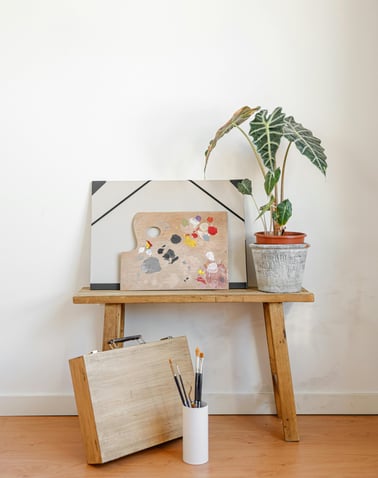How to Set Up an Affordable Home Art Studio
Art and anomaly offers practical tips for creating a functional and inspiring workspace without breaking the bank. This guide covers essential supplies, space-saving solutions, and DIY ideas to help artists of all levels transform any room or corner into a comfortable and budget-friendly art studio. Whether you're working in a small space or want to make the most of limited resources, this article will help you design a studio that fosters creativity and productivity.
10/16/20243 min read


Creating an art studio at home can seem like a daunting task, especially if you're on a budget. However, with a little creativity and resourcefulness, you can set up an affordable art space that inspires your creativity and helps you work efficiently. This guide will provide practical tips to help you transform any corner of your home into a functional and inviting art studio without overspending.
1. Choose the Right Space
The first step in setting up your home art studio is selecting the right location. Look for a space that meets your needs, whether it’s a spare room, a corner of your living room, or even a well-lit closet. Consider the following factors:
Natural Light: If possible, choose a space with plenty of natural light. Good lighting can enhance your mood and help you see colors more accurately.
Ventilation: Ensure the area is well-ventilated, especially if you’ll be using materials with strong fumes, like oil paints or solvents.
Quiet and Comfortable: A quiet space free from distractions will allow you to focus on your work. Make sure you have enough room to move around comfortably.
2. Gather Essential Supplies
When setting up your studio, you don't need to buy everything at once. Start with the essentials and gradually add to your collection as you go. Here’s a list of basic supplies to consider:
Drawing or Painting Surfaces: Stock up on sketchbooks, canvases, or drawing paper based on your preferred medium.
Tools: Depending on your medium, gather brushes, pencils, markers, or other tools. Look for affordable options at local art supply stores or online.
Storage Solutions: Use containers, baskets, or shelves to organize your materials. Repurpose items you already have around the house, such as jars or boxes, to store supplies neatly.
3. Get Creative with Furniture
Setting up an art studio doesn’t have to mean buying expensive furniture. Consider these budget-friendly options:
Repurpose Existing Furniture: Use a sturdy table or desk you already own as your work surface. An old dining table or a desk can serve as a great workspace.
DIY Solutions: If you’re handy, consider building your own easel or storage units. There are plenty of tutorials online for DIY art studio furniture that can save you money.
Multifunctional Furniture: Look for furniture that can serve multiple purposes. For instance, a cart with wheels can be used for storage and as a mobile workspace.
4. Incorporate Inspiration
Your art studio should inspire you to create. Personalize the space to reflect your style and interests:
Display Art: Hang your own artwork or pieces from artists you admire. This can serve as motivation and spark creativity.
Mood Board: Create a mood board with images, colors, and textures that inspire you. This can help set the tone for your creative space.
Plants and Decor: Add plants or decorations that brighten the room and create a welcoming atmosphere. You can often find affordable options at local thrift stores or garden centers.
5. Organize Your Space
An organized studio can enhance productivity and make it easier to find materials when you need them. Consider these tips for keeping your studio tidy:
Use Labels: Label boxes or containers to quickly identify what’s inside. This will save you time when searching for specific supplies.
Create Zones: Set up different areas for various tasks, such as drawing, painting, or mixed media. This can help you stay organized and focused.
Keep it Minimal: Avoid overcrowding your studio with supplies you rarely use. Regularly assess your materials and donate or recycle what you don’t need.
6. Prioritize Comfort
Since you'll be spending time in your art studio, it's essential to make it comfortable. Here are some ways to enhance your workspace:
Ergonomic Seating: Invest in a good chair that provides support, especially if you'll be sitting for long periods. Look for second-hand options if you’re on a tight budget.
Adjustable Lighting: Use a combination of natural light and adjustable lamps to ensure your workspace is well-lit. Consider using desk lamps or floor lamps for extra illumination.
Keep It Cozy: Add soft furnishings like cushions, a blanket, or an area rug to make the space feel inviting and comfortable.
7. Make Time for Your Art
Finally, remember that a studio is just a space; what matters most is making time to create. Schedule regular art sessions and treat them as you would any important appointment. Setting aside dedicated time will help you stay motivated and productive in your new studio.
Conclusion
Setting up an affordable home art studio is entirely possible with a little creativity and planning. By choosing the right space, gathering essential supplies, and personalizing your environment, you can create a functional and inspiring studio that fosters your artistic endeavors. Remember, your studio should reflect your style and serve as a sanctuary for creativity. So roll up your sleeves, get organized, and start making art!
4o mini
Creativity
Explore art, learn, and embrace your passion.
CONTACT US:
Expression
artandanomaly@gmail.com
© 2024. All rights reserved.
